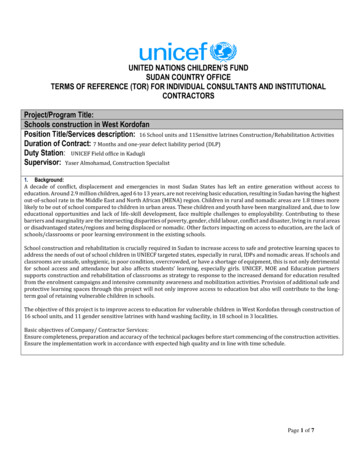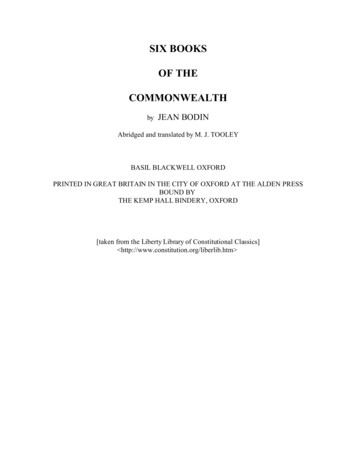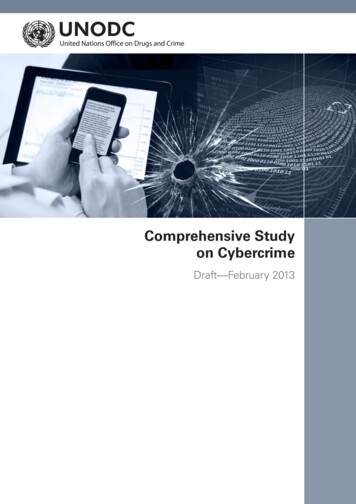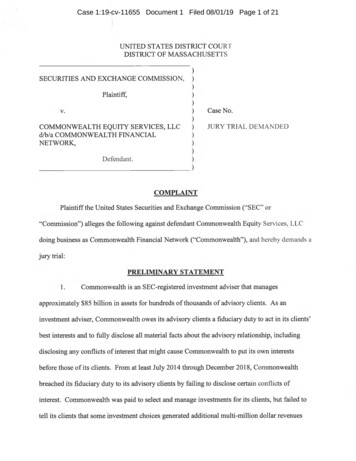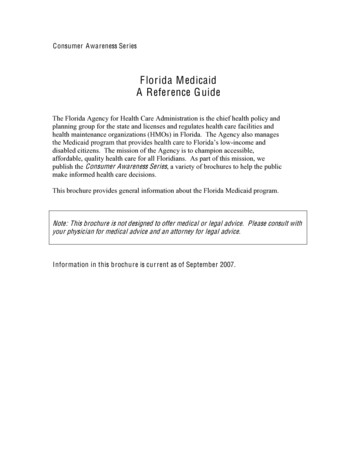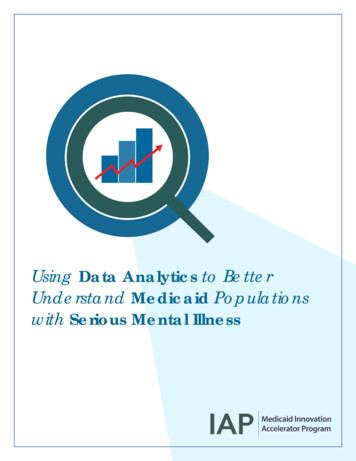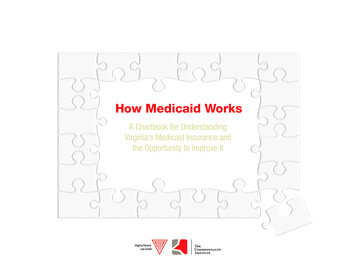
Transcription
How Medicaid WorksA Chartbook for UnderstandingVirginia’s Medicaid Insurance andthe Opportunity to Improve itVirginia PovertyLaw CenterTheCommonwealthInstitute
SECTION s MedicaidProgram Today
Virginia’s Medicaid Plays An Important Rolein Health Coverage1 in 10of allVirginians1 in 5of allpoor adults in Virginia*1 in 2of allpoor kids in Virginia* Poor is defined as 100% Federal Poverty LevelSource: Kaiser Family FoundationMedicaid is a public health insurance programfor low-income people. It was started in 1965.Medicaid insurance covers mostly seniors innursing homes, people with disabilities, pregnantwomen, children, and working families.In Virginia, over 834,000 people have healthcoverage through Medicaid.Medicaid is jointly funded through federal andstate dollars and administered by the state.Every dollar Virginia spends in Medicaid ismatched by a dollar in federal funds.2TheCommonweaInstitute
Eligibility levels determine who can receivecoverage.States set eligibility levels based on personalincome and assets.3Virginia has very restrictive Medicaid eligibility: Pregnant women and children up to age 18cannot have income higher than 133 percentof federal poverty level (FPL) or 25,390 fora family of three. (Virginia’s FAMIS programcovers children and pregnant women up to 200percent FPL or 38,180 for a family of three.)Who Gets Medicaid in Virginia?Several populations are covered and each group has its own incomeeligibility guidelines.To be eligible, countable income cannot be higher thanof theFederalPoverty133% LevelChildren 0-18133%Pregnant WomenElderly & Disabled80%TheCommonwealthInstitute Elderly and disabled people cannot haveincome higher than 80 percent FPL or 15,272for a family of three. Working parents cannot have income higherthan 30 percent FPL or 5,727 for a familyof three. Childless adults are not eligible for Medicaidin Virginia.Working Parents30%Childless Adultsnot eligibleSource: DMAS
How lean is Virginia’s Medicaid program today?44thOnly 6 states make it harder forworking parents to get Medicaid.If a family of 3 lives inand has an annualcountable income ofCounties: Accomack, Alleghany, Amelia, Amherst,Appomattox, Bath, Bedford, Bland, Botetourt, Brunswick,Buchanan, Buckingham, Campbell, Caroline, Carroll,Charles City, Charlotte, Clarke, Craig, Culpeper,Cumberland, Dickenson, Dinwiddie, Essex, Fauquier,Floyd, Fluvanna, Franklin, Frederick, Giles, Gloucester,Goochland, Grayson, Greene, Greensville, Halifax,Hanover, Henry, Highland, Isle of Wight, James City, KingGeorge, King & Queen, King William, Lancaster, Lee,Louisa, Lunenburg, Madison, Mathews, Mecklenburg,Middlesex, Nelson, New Kent, Northampton, Northumberland, Nottoway, Orange, Page, Patrick, Pittsylvania,Powhatan, Prince Edward, Prince George, Pulaski,Rappahannock, Richmond County, Rockbridge, Russell,Scott, Shenandoah, Smyth, Southampton, Spotsylvania,Stafford, Surry, Sussex, Tazewell, Washington, Westmoreland, Wise, Wythe, YorkCities: Bristol, Buena Vista, Danville, Emporia, Franklin,Galax, Norton, Suffolk 4,337Counties: Albemarle, Augusta, Chesterfield, Henrico,Loudoun, Roanoke, Rockingham, WarrenCities: Chesapeake, Covington, Harrisonburg, Hopewell,Lexington, Lynchburg, Martinsville, Newport News,Norfolk, Petersburg, Portsmouth, Radford, Richmond,Roanoke, Staunton, Virginia Beach, Williamsburg,Winchester 4,763Counties: Arlington, Fairfax, Montgomery, Prince WilliamCities: Alexandria, Charlottesville, Colonial Heights, FallsChurch, Fredericksburg, Hampton, Manassas, ManassasPark, Waynesboro 5,794Because the maximum allowable income is solow and varies by locality, working parents canend up losing their eligibility with just a littleovertime or even a promotion that comes with aslightly higher salary.Or, if they have to move to another Virginialocality, they may suddenly find they have losttheir eligibility.4TheCommonweaInstitutethey would likely be ineligible for MedicaidSources: DSS, Kaiser Family FoundationFor working parents, maintaining eligibility is ahigh-wire act.
The recent recession caused many Virginians tolose their jobs and their health insurance.When Economic Cycle is Down, MedicaidEnrollment Increases (2008-2009)As a result, more people enrolled in Medicaid,and Medicaid costs increased.That is how Medicaid is supposed to work.During economic downturns, more people signup and costs rise. When the economy recovers,fewer people enroll and costs ease.Decrease innumber of jobsin Virginia from3.8 million to3.6 million5Decrease instate’semployersponsoredinsurance from65% to se instate’sMedicaid/CHIPenrollmentfrom 746,939to 789,952Increase instate’suninsured ratefrom 11.8% to12.6%Sources: Current Population Survey, Bureau of Labor Statistics, DSS
Medicaid Controls Costs BetterBetween 2000-2009, the growth in per person cost was muchlower in Medicaid than in the private insurance market.8%77.2%Far from broken, Medicaid is actually veryefficient. Medicaid has lower administrative coststhan private insurance, and its rate of growth hasbeen much slower than private insurance.65464.6%TheCommonweaInstitute3210Because health care costs have been rising acrossthe economy for many years, Medicaid costshave been rising, too. When compared to thestate budget, which has been shrinking for thepast few years, it can look like Medicaid costs arerising rapidly.Medicaid(Per Beneficiary)Private Insurance Companies(Per Capita)Source: Center on Budget and Policy Priorities analysis
SECTION �s Opportunityto Improve Medicaid
Health Insurance MattersThe debate surrounding the expansion of Virginia’s Medicaid insurance program has focused on costs,but has ignored an equally important issue: the value of health insurance. Three recent studies showjust what kind of value health care coverage delivers for individuals and ECONTROLSCOSTS8TheCommonweaInstitute25%less likely to have anunpaid medical bill40%less likely to borrow money or fail48.3%decrease in average6.1%relative reduction inmortality rateshealth care costs per year1st year 8,900320 per 100,000States that expandedMedicaid eligibilityto pay other bills because ofmedical debt3rd year 4,600344 per 100,000States that did notexpand MedicaidResults compare people with Medicaidinsurance versus people who areuninsured.Results compare people without healthinsurance who gained coverage through aVCU program for 1 year versus 3 years. Thoseinsured for 3 years had fewer emergency roomand more regular doctor visits.Results compare the entire adult population instates that expanded Medicaid eligibility (NY,ME, AZ) versus neighboring states that did not(NH, PA, NV, and NM).Sources: Health Affairs, The New England Journal of Medicine, National Bureau of Economic Research
9The Affordable Care Act (ACA) offers states anoption to increase Medicaid eligibility for allgroups to 133 percent FPL starting January 1,2014. In addition, there is a 5 percent incomedisregard which effectively raises eligibility to138 percent FPL. This is equal to an annualincome of 26,344 for a family of three in 2012.How does Expansion Change Eligibility?Children 0-18133%This expanded eligibility would primarily helpparents and other working adults who are notoffered coverage through their jobs and cannotafford other coverage.Pregnant Women133%Disabled adults133%Working Parents133%Childless Adults133%TheCommonwealthInstituteThe ACA also requires states to allow formerfoster youth who have aged out of the system tocontinue to receive Medicaid coverage.New coverage groups will be added and the income eligibility willincrease up to 133% of the federal poverty level for most adults.not needing long-termcare servicesCurrently eligibleSource: DMASNewly eligible
Medicaid Expansion Bridges the GapIDEXPANSINMDAICOEIf Virginia chooses not to expand Medicaid, thousands of Virginians will fall into a ‘no-coverage ravine’-- unable to enroll inMedicaid and barred from getting tax credits to buy coverage in the new health insurance exchange.10HEALTH INSURANCEEXCHANGECURRENT VIRGINIAMEDICAID PROGRAM0% FPL30% FPL100%FPL% of the Federal Poverty Level (FPL)*Note: Under the current Virginia Medicaid program, working parents may be eligible for coverage if income is under 30% of FPL.Pregnant women can get coverage up to 200% of FPL during their pregnancy and children are covered up to 200% FPL in FAMIS. Aged,blind, and disabled individuals are covered up to 80% of FPL.Source: Department of Medical Assistance Services and IRS Revenue Bulletin Sept. 6, 2011400%FPLTheCommonweaInstitute
Medicaid Expansion is a Great Deal for VirginiaThe federal government will cover the vast majority of the costs ofexpanding Medicaid. Other public health programs require far morestate investment.11TheCommonwealthInstitute 5VIRGINIA 5FEDERAL50:50Current Medicaid 3.50VIRGINIA 6.50FEDERAL35:65FAMIS 0VIRGINIA 10FEDERAL0:100Medicaid ExpansionUnder the ACA in 2014-2016Match for newly eligible group 1VIRGINIA10:90Medicaid ExpansionUnder the ACA beyond 2020Match for newly eligible groupComparing federal and state shares of funding for public health programsSource: Kaiser Family Foundation 9FEDERAL
Medicaid is the WorkhorseThe Affordable Care Act can help over 500,000 uninsured Virginians gethealth insurance, mostly through the expansion of Medicaid. If Virginiafails to expand Medicaid, thousands of Virginians will be left behind.When working families have health insurance,parents can go to work and children can go toschool knowing they will be able to see a doctorif they need to. And instead of seeking routinecare in the emergency room, Virginians will beable to get quality, consistent care at a lower cost.MEDICAID420,000Uninsured VirginiansPotentially Eligible forACA’s MedicaidExpansionTHE EXCHANGE106,000Uninsured Virginiansto Get Coveragethrough the ExchangeSources: Urban Institute,TCI analysisIn Virginia, the largest reduction in the numberof people who are uninsured would be due to theMedicaid expansion.The most recent state estimates indicate that241,100 of the newly eligible Medicaid recipientswould enroll. Of these, 175,000 would be adults,65,000 would be working parents, and 1,100would be adults with disabilities.12TheCommonweaInstitute
13TheCommonwealthInstitute
Medicaid Expansion Covers Workers inKey Job SectorsTourism31,900Retail Trade24,500Educational, Health andSocial Services24,300ConstructionThe majority of people who would be newlyeligible for coverage are working. And they areworking in the most important sectors ofour economy.18,500Professional, Scientific,Management, Administrative, and Waste Management Services18,000Other Services (ExceptPublic Administration)Workers in five of the state’s six largestemployment sectors have the most to gain:Tourism; Retail Trade; Educational, Health, andSocial Services; Construction; and Professional,Scientific, Management, Administrative, andWaste Management Services.14,300Manufacturing7,400Transportation andWarehousing6,0006,000Finance, Insurance,Real Estate, and Rentaland LeasingPublic AdministrationExpanding Medicaid is a smart investmentin the hard-working people who call Virginiahome, raise their families here, and make theeconomy tick.4,0003,300Other7,10005,00010,00015,000 20,000number of workers25,00030,000Note: Other includes Wholesale Trade, Information and Communications, Agriculture/Forestry/Fishing/Hunting, Mining, Utilities, and Armed ForcesSource: TCI analysis of 2010 ACS data retrieved from IPUMS35,00014TheCommonweaInstitute
Annually, the state could expect an infusion of 2.6 billion per year of federal funds, whichcould add up to 21 billion through 2021.The bulk of those resources will flow directlyinto Virginia’s health care sector, resulting inincreased employment in the full range of jobsrequired by that sector, an already importantpart of Virginia’s economy.15In Virginia, the average health care sector job pays 49,054. An annual infusion of 2.6 billion couldsupport 26,700 health care jobs in the state.Booster Shot to Virginia’s EconomyNew federal resources would bring new jobs and revenue to the state. 2.6 billion/yearin federal fundingTheCommonwealthInstituteThose additional health care jobs could thentranslate into over 85 million in state and localrevenues each year, giving the state economy anextra boost.A healthier, more productive workforce leads toa growing state economy, more local jobs and avibrant future.Sources: Senate Finance Committee, TCI analysisJobs26,700 New TaxRevenues85.2 million
Medicaid Expansion Pays For Itself20142017Savings Inside of Medicaid2021 339 millionSavings Outside of Medicaid 1.25 billionNew General Fund Revenue 493 millionState’s Shareof Expansion 1.02 billionExpanding Medicaid coverage would generatestate savings and new revenue that are twicethe cost over the next eight years (2014 - 2021).That is because expanding Medicaid would helpreduce state costs for health care provided topeople who do not have health insurance now,but would be covered by Medicaid in 2014.There would be savings in the state’s Medicaidprogram totaling 339 million from pharmacyrebates and federal funds for programs currentlyfunded with general funds.Additional savings totaling 1.25 billion wouldalso occur outside of the state’s Medicaidprogram through reducing the need for indigentcare subsidies, supplanting general fund dollarswith federal dollars, and reducing the increase inthe cost of state employees’ health premiums.The state would also find itself with 493million of additional tax revenue as a result of theincreased health sector employment (as describedin the previous chart).NET State General Fund SavingsSources: Senate Finance Committee, House Appropriations Committee, TCI analysis 1.06 billionThe new Medicaid coverage would require statecontributions totaling 1.02 billion over eightyears, resulting in a net savings to the state of 1.06 billion.Although the specific savings and costs ofMedicaid expansion will depend on the numberof people who actually enroll, at every level ofenrollment there will be related savings and newrevenue for the state.16TheCommonweaInstitute
For more information, contact:Michael J. CassidyPresident & CEOThe Commonwealth Institute forFiscal 6-2051Jill A. Hanken17Health AttorneyVirginia Poverty Law Centerjill@vplc.org804-782-9430 x13The Commonwealth InstituteTheThe Commonwealth Institute for Fiscal Analysis provides credible,Commonwealthindependent and accessible information and analyses of state public policiesInstitutewith particular attention to the impacts on low- and moderate-incomepersons. Our products inform state economic, fiscal, and budget policydebates and contribute to sound decisions that improve the well-being ofindividuals, communities and Virginia as a whole.The Virginina Poverty Law CenterThe Virginia Poverty Law Center is a non-profit organization that servesVirginia’s legal aid system by providing advocacy, training, and litigationsupport on civil justice issues that affect low-income Virginians.TheCommonwealthInstituteThis work is licensed under the Creative Commons Attribution-NonCommercialNoDerivs 3.0 Unported License. To view a copy of this license, 3.0/ or send a letter to CreativeCommons, 444 Castro Street, Suite 900, Mountain View, California, 94041, USA.
Virginia PovertyLaw CenterTheCommonwealthInstitute
Medicaid is a public health insurance program for low-income people. It was started in 1965. Medicaid insurance covers mostly seniors in nursing homes, people with disabilities, pregnant women, children, and working families. In Virginia, over 834,000 people have health coverage through Medicaid. Medicaid is jointly funded through federal and




